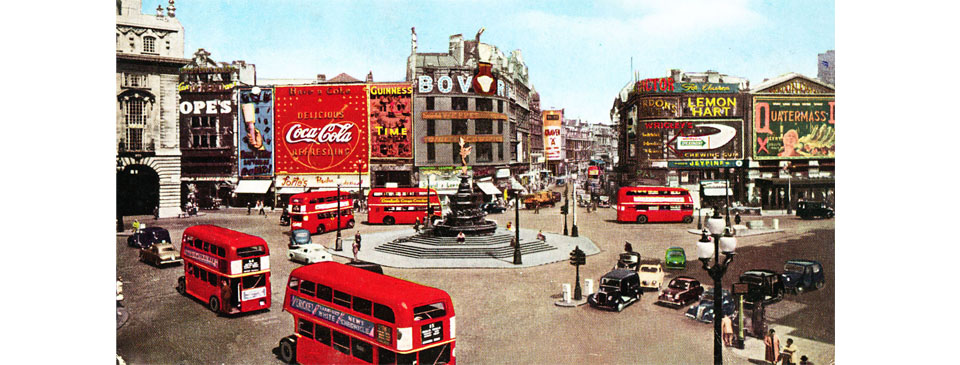In brief – Late-20th century London

Traffic flows around the Shaftesbury Memorial fountain at Piccadilly Circus in about 1955. The Bovril and Guinness advertisements had been in place for several decades when they were joined by Coca Cola shortly before this photo was taken. The film Quatermass Experiment is showing at the London Pavilion cinema.
Early in the 20th century the word ‘smog’ came into use to describe the combination of natural, low cloud and man-made smoke full of sulphur oxides that plagued London. The worst occurrence was the ‘Great Smog’ of December 1952 that lasted for days and brought the capital to a standstill. At least three and a half thousand premature deaths from asthma were immediately attributed to that occurrence. It was estimated that a further 8,000 deaths were caused during the following months by those few days of smog. The Great Smog led to a Private Member’s Bill in Parliament in 1956 that created the Clean Air Act. Local authorities were given discretionary powers to create smoke-free zones. There was further legislation in 1968, coinciding with an increasing number of new homes heated by gas-fuelled centrally-heated radiators, bringing an end to the annual smogs, the last major occurrence of which was in 1974.
The Second World War bred a new generation of criminal gangs in London, carrying out protection racketeering and organising well-planned robberies and burglaries. The wartime armed services had educated many in the use of weapons and organisational skills. The 1960s saw the end of London’s permanent gangs built around a family or leader and the rise of a new breed of criminal unit brought together for a specific job. The last of the dying breed were the Richardsons from Camberwell, the Krays from Bethnal Green, the Adams family in Islington, and the Arif brothers in Stockwell. Criminals began to target cash and other valuables while they were in transit. Narcotics became the main business of organised crime in the latter part of the century, connected to international money laundering and the illegal gun trade, as well as protection racketeering.
In 1967 Scotland Yard, the headquarters of the Metropolitan Police, moved from the Norman Shaw Building on the Embankment to a new home at Broadway, just off Victoria Street, to be known as New Scotland Yard. Corruption within the CID section of the Metropolitan police became a serious and widespread issue after the Second World War. Gambling and drinking dens bribed officers to turn a blind eye and in some cases innocent business people were blackmailed to provide protection money. The Met Commissioner Sir Paul Condon estimated in the late 1990s there were 250 corrupt CID officers. There was much resentment towards the police from the black community, with a strong suspicion of racism. It was highlighted by the Macpherson Report, published in February 1999 following dissatisfaction with the Met’s bungled handling of the murder of the black teenager Stephen Lawrence in Eltham six years earlier.
London had long expanded beyond the area covered by the County of London and its administrative authority the London County Council and thus there was no overall body to cover conurbation-wide issues. The London Government Act of 1963 solved the problem by changing the external and internal boundaries of London. The whole of the former London county, plus parts of Hertfordshire, Essex, Kent and Surrey became the new Greater London. Middlesex was completely taken off the map, mostly absorbed into London but with some parts transferred to Hertfordshire. Greater London was divided into thirty-two boroughs, plus the City of London. In the main those larger entities were created by the amalgamation of either two or three former boroughs, an unpopular and strongly-resisted policy at the time.
At the same time the LCC was abolished and replaced by the Greater London Council, which took over an area four times that of its predecessor. The Inner London Education Authority became responsible for schools within the twelve inner boroughs while each of the other twenty boroughs became an education authority in their own right. The borders of the Metropolitan Police area were also adjusted, taking in the entire Greater London together with some outlying districts.
Unlike the LCC the GLC struggled to find a purpose. It often squabbled with local boroughs or central government. For much of its life it was controlled by Labour, which itself was divided by rival left-wing groups. From amongst the in-fighting Ken Livingstone emerged as the new GLC leader in 1981. That led to further disagreements with the national Conservative government and in 1986 to the abolition of the GLC, leaving the capital without an overall administrative body.
